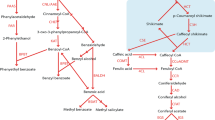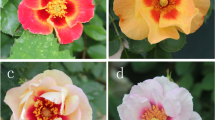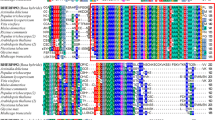Abstract
Rose flowers, like flowers and fruits of many other plants, produce and emit the aromatic volatiles 2-phenylacetaldehyde (PAA) and 2-phenylethylalchohol (PEA) which have a distinctive flowery/rose-like scent. Previous studies in rose have shown that, similar to petunia flowers, PAA is formed from l-phenylalanine via pyridoxal-5′-phosphate-dependent l-aromatic amino acid decarboxylase. Here we demonstrate the use of a Saccharomyces cerevisiae aro10∆ mutant to functionally characterize a Rosa hybrida cv. Fragrance Cloud sequence (RhPAAS) homologous to petunia phenylacetaldehyde synthase (PhPAAS). Volatile headspace analysis of the aro10∆ knockout strain showed that it produces up to eight times less PAA and PEA than the WT. Expression of RhPAAS in aro10∆ complemented the yeast’s mutant phenotype and elevated PAA levels, similar to petunia PhPAAS. PEA production levels were also enhanced in both aro10∆ and WT strains transformed with RhPAAS, implying an application for metabolic engineering of PEA biosynthesis in yeast. Characterization of spatial and temporal RhPAAS transcript accumulation in rose revealed it to be specific to floral tissues, peaking in mature flowers, i.e., coinciding with floral scent production and essentially identical to other rose scent-related genes. RhPAAS transcript, as well as PAA and PEA production in flowers, displayed a daily rhythmic behavior, reaching peak levels during the late afternoon hours. Examination of oscillation of RhPAAS transcript levels under free-running conditions suggested involvement of the endogenous clock in the regulation of RhPAAS expression in rose flowers.






Similar content being viewed by others
References
Beekwilder J, Alvarez-Huerta M, Neef E, Verstappen FWA, Bouwmeester HJ, Aharoni A (2004) Functional characterization of enzymes forming volatile esters from strawberry and banana. Plant Physiol 135:1865–1878. doi:10.1104/pp.104.042580
Boatright J, Negre F, Chen XL, Kish CM, Wood B, Peel G, Orlova I, Gang D, Rhodes D, Dudareva N (2004) Understanding in vivo benzenoid metabolism in petunia petal tissue. Plant Physiol 135:1993–2011. doi:10.1104/pp.104.045468
Brunke EJ, Hammerschmidt FJ, Schmaus G (1992) Scent of roses recent results. Flavour Frag J 7:195–198
Channlière S, Rivière S, Scalliet G, Szecsi J, Jullien F, Dolle C, Vergne P, Dumas C, Bendahmane M, Hugueney P, Cock JM (2002) Analysis of gene expression in rose petals using expressed sequence tags. FEBS Lett 515:35–38
Chen H, Fink GR (2006) Feedback control of morphogenesis in fungi by aromatic alcohols. Genes Dev 20:1150–1161. doi:10.1101/gad.1411806
Clark GS (1990) Phenethyl alcohol. Perfumer Flavor 15:37–44
Cseke LJ, Kaufman PB, Kirakosyan A (2007) The biology of essential oils in the pollination of flowers. Nat Prod Commun 2:1317–1336
Dobres MS (2008) Barriers to genetically engineered ornamentals: an industry perspective. In: da-Silva JAT (ed) Floriculture, ornamental and plant biotechnology. Global Science Books, UK, pp 1–115
Dudareva N, Pichersky E (2006) Biology of floral scent. CRC Press-Taylor & Francis Group, Boca Raton
Dudareva N, Murfitt LM, Mann CJ, Gorenstein N, Kolosova N, Kish CM, Bonham C, Wood K (2000) Developmental regulation of methyl benzoate biosynthesis and emission in snapdragon flowers. Plant Cell 12:949–961. doi:10.1105/tpc.12.6.949
Etschmann MMW, Schrader J (2006) An aqueous-organic two-phase bioprocess for efficient production of the natural aroma chemicals 2-phenylethanol and 2-phenylethylacetate with yeast. Appl Microbiol Biotechnol 71:440–443. doi:10.1007/s00253-005-0281-6
Farhi M, Dudareva N, Masci T, Weiss D, Vainstein A, Abeliovich H (2006) Synthesis of the food flavoring methyl benzoate by genetically engineered Saccharomyces cerevisiae. J Biotechnol 122:307–315. doi:10.1016/j.jbiotec.2005.12.007
Flament I, Debonneville C, Furrer A (1993) Volatile constituents of roses—characterization of cultivars based on the headspace analysis of living flower emissions. Bioactive Volatile Compd Plants 525:269–281
Fridman E, Pichersky E (2005) Metabolomics, genomics, proteomics, and the identification of enzymes and their substrates and products. Curr Opin Plant Biol 8:242–248. doi:10.1016/j.pbi.2005.03.004
Gao F, Daugulis AJ (2009) Bioproduction of the aroma compound 2-phenylethanol in a solid-liquid two-phase partitioning bioreactor system by Kluyveromyces marxianus. Biotechnol Bioeng 104:332–339. doi:10.1002/bit.22387
Gietz RD, Woods RA (2002) Transformation of yeast by lithium acetate/single-stranded carrier DNA/polyethylene glycol method. Guide to yeast genetics and molecular and cell biology. Methods Enzymol 350:87–96
Guterman I, Shalit M, Menda N, Piestun D, Dafny-Yelin M, Shalev G, Bar E, Davydov O, Ovadis M, Emanuel M, Wang J, Adam Z, Pichersky E, Lewinsohn E, Zamir D, Vainstein A, Weiss D (2002) Rose scent: genomics approach to discovering novel floral fragrance-related genes. Plant Cell 14:2325–2338. doi:10.1105/tpc.005207
Hayashi S, Yagi K, Ishikawa T, Kawasaki M, Asai T, Picone J, Turnbull C, Hiratake J, Sakata K, Takada M, Ogawa K, Watanabe N (2004) Emission of 2-phenylethanol from its β-D-glucopyranoside and the biogenesis of these compounds from [H-2(8)] l-phenylalanine in rose flowers. Tetrahedron 60:7005–7013. doi:10.1016/j.tet.2003.10.130
Hazelwood LA, Daran J-M, van Maris AJA, Pronk JT, Dickinson JR (2008) The Ehrlich pathway for fusel alcohol production: a century of research on Saccharomyces cerevisiae metabolism. Appl Environ Microbiol 74:2259–2266. doi:10.1128/aem.02625-07
Helsper J, Davies JA, Bouwmeester HJ, Krol AF, van Kampen MH (1998) Circadian rhythmicity in emission of volatile compounds by flowers of Rosa hybrida L. cv. Honesty. Planta 207:88–95
Hendel-Rahmanim K, Masci T, Vainstein A, Weiss D (2007) Diurnal regulation of scent emission in rose flowers. Planta 226:1491–1499. doi:10.1007/s00425-007-0582-3
Kaminaga Y, Schnepp J, Peel G, Kish CM, Ben-Nissan G, Weiss D, Orlova I, Lavie O, Rhodes D, Wood K, Porterfield DM, Cooper AJL, Schloss JV, Pichersky E, Vainstein A, Dudareva N (2006) Plant phenylacetaldehyde synthase is a bifunctional homotetrameric enzyme that catalyzes phenylalanine decarboxylation and oxidation. J Biol Chem 281:23357–23366. doi:10.1074/jbc.M602708200
Knudsen JT, Tollsten L, Bergstrom LG (1993) Floral scents—a checklist of volatile compounds isolated by headspace techniques. Phytochemistry 33:253–280
Kolosova N, Gorenstein N, Kish CM, Dudareva N (2001) Regulation of circadian methyl benzoate emission in diurnally and nocturnally emitting plants. Plant Cell 13:2333–2347. doi:10.1105/tpc.13.10.2333
Lavid N, Wang J, Shalit M, Guterman I, Bar E, Beuerle T, Menda N, Shafir S, Zamir D, Adam Z, Vainstein A, Weiss D, Pichersky E, Lewinsohn E (2002) O-Methyltransferases involved in the biosynthesis of volatile phenolic derivatives in rose petals. Plant Physiol 129:1899–1907. doi:10.1104/pp.005330
Lavie O (2006) Identification and characterization of genes involved in the biosynthesis of scent volatile phenylacetaldehyde. M.Sc., Thesis, The Hebrew University of Jerusalem
Leclercq-Perlat MN, Corrieu G, Spinnler HE (2004) Comparison of volatile compounds produced in model cheese medium deacidified by Debaryomyces hansenii or Kluyveromyces marxianus. J Dairy Sci 87:1545–1550
Moyal Ben Zvi M, Negre-Zakharov F, Masci T, Ovadis M, Shklarman E, Ben-Meir H, Tzfira T, Dudareva N, Vainstein A (2008) Interlinking showy traits: co-engineering of scent and colour biosynthesis in flowers. Plant Biotechnol J 6:403–415. doi:10.1111/j.1467-7652.2008.00329.x
Pichersky E, Dudareva N (2007) Scent engineering: toward the goal of controlling how flowers smell. Trends Biotechnol 25:105–110
Pichersky E, Noel JP, Dudareva N (2006) Biosynthesis of plant volatiles: nature’s diversity and ingenuity. Science 311:808–811. doi:10.1126/science.1118510
Picone JM, Clery RA, Watanabe N, MacTavish HS, Turnbull CGN (2004) Rhythmic emission of floral volatiles from Rosa damascena semperflorens cv. ‘Quatre Saisons’. Planta 219:468–478
Pittendrigh CS (1960) Circadian rhythms and the circadian organization of living systems. Cold Spring Harbor symposia on quantitative biology. Cold Spring Harbor Laboratory Press, NY, pp 159–184
Rose USR, Tumlinson JH (2005) Systemic induction of volatile release in cotton: how specific is the signal to herbivory? Planta 222:327–335. doi:10.1007/s00425-005-1528-2
Rose M, Kotter P, Hauf J, Entian KD (2003) The yeast strain collection EUROSCARF: a source for useful tools in yeast genetics and molecular biology. Yeast 20:S343
Sakai M, Hirata H, Sayama H, Sekiguchi K, Itano H, Asai T, Dohra H, Hara M, Watanabe N (2007) Production of 2-phenylethanol in roses as the dominant floral scent compound from l-phenylalanine by two key enzymes, a PLP-dependent decarboxylase and a phenylacetaldehyde reductase. Biosci Biotechnol Biochem 71:2408–2419
Sakai M, Tomita S, Hirata H, Asai T, Dohra H, Hara M, Watanabe N (2008) Purification and characterization of β-glucosidase involved in the emission of 2-phenylethanol from rose flowers. Biosci Biotechnol Biochem 72:219–221
Scalliet G, Journot N, Jullien F, Baudino S, Magnard JL, Channeliere S, Vergne P, Dumas C, Bendahmane M, Cock JM, Hugueney P (2002) Biosynthesis of the major scent components 3, 5-dimethoxytoluene and 1, 3, 5-trimethoxybenzene by novel rose O-methyltransferases. FEBS Lett 523:113–118
Scalliet G, Piola F, Douady CJ, Rety S, Raymond O, Baudino S, Bordji K, Bendahmane M, Dumas C, Cock JM, Hugueney P (2008) Scent evolution in Chinese roses. Proc Natl Acad Sci USA 105:5927–5932. doi:10.1073/pnas.0711551105
Schiestl FP, Ayasse M, Paulus HF, Lofstedt C, Hansson BS, Ibarra F, Francke W (1999) Orchid pollination by sexual swindle. Nature 399:421–422
Schuurink RC, Haring MA, Clark DG (2006) Regulation of volatile benzenoid biosynthesis in petunia flowers. Trends Plant Sci 11:20–25
Shalit M, Shafir S, Larkov O, Bar E, Kaslassi D, Adam Z, Zamir D, Vainstein A, Weiss D, Ravid U, Lewinsohn E (2004) Volatile compounds emitted by rose cultivars: fragrance perception by man and honeybees. Israel J Plant Sci 52:245–255
Sharkey TD, Wiberley AE, Donohue AR (2008) Isoprene emission from plants: why and how. Ann Bot 101:5–18. doi:10.1093/aob/mcm240
Spitzer B, Zvi MMB, Ovadis M, Marhevka E, Barkai O, Edelbaum O, Marton I, Masci T, Alon M, Morin S, Rogachev I, Aharoni A, Vainstein A (2007) Reverse genetics of floral scent: application of Tobacco rattle virus-based gene silencing in Petunia. Plant Physiol 145:1241–1250. doi:10.1104/pp.107.105916
Takahashi S, Yeo Y, Greenhagen BT, McMullin T, Song L, Maurina-Brunker J, Rosson R, Noel JP, Chappell J (2007) Metabolic engineering of sesquiterpene metabolism in yeast. Biotechnol Bioeng 97:170–181. doi:10.1002/bit.21216
Tieman D, Taylor M, Schauer N, Fernie AR, Hanson AD, Klee HJ (2006) Tomato aromatic amino acid decarboxylases participate in synthesis of the flavor volatiles 2-phenylethanol and 2-phenylacetaldehyde. Proc Natl Acad Sci USA 103:8287–8292. doi:10.1073/pnas.0602469103
Tieman DM, Loucas HM, Kim JY, Clark DG, Klee HJ (2007) Tomato phenylacetaldehyde reductases catalyze the last step in the synthesis of the aroma volatile 2-phenylethanol. Phytochemistry 68:2660–2669. doi:10.1016/j.phytochem.2007.06.005
Vainstein A, Lewinsohn E, Weiss D (2006) An integrated genomics approach to identifying floral scent genes in rose. In: Dudareva N, Pichersky E (eds) Biology of floral scent. CRC Press-Taylor & Francis Group, Boca Raton, pp 91–102
Verdonk JC, Haring MA, van Tunen AJ, Schuurink RC (2005) ODORANT1 regulates fragrance biosynthesis in petunia flowers. Plant Cell 17:1612–1624. doi:10.1105/tpc.104.028837
Vuralhan Z, Morais MA, Tai S-L, Piper MDW, Pronk JT (2003) Identification and characterization of phenylpyruvate decarboxylase genes in Saccharomyces cerevisiae. Appl Environ Microbiol 69:4534–4541. doi:10.1128/aem.69.8.4534-4541.2003
Watanabe S, Hayashi K, Yagi K, Asai T, Mactavish H, Picone J, Turnbull C, Watanabe N (2002) Biogenesis of 2-phenylethanol in rose flowers: incorporation of [2H8]l-phenylalanine into 2-phenylethanol and its β-D-glucopyranoside during the flower opening of Rosa ‘Hoh-Jun’ and Rosa damascena Mill. Biosci Biotechnol Biochem 66:943–947
Westermann B, Neupert W (2000) Mitochondria-targeted green fluorescent proteins: convenient tools for the study of organelle biogenesis in Saccharomyces cerevisiae. Yeast 16:1421–1427
Yang Z, Sakai M, Sayama H, Shimeno T, Yamaguchi K, Watanabe N (2009) Elucidation of the biochemical pathway of 2-phenylethanol from shikimic acid using isolated protoplasts of rose flowers. J Plant Physiol 166:887–891
Yitzhak E (2004) Genomic approach to studying rose floral scent. M.Sc., thesis, The Hebrew University of Jerusalem
Acknowledgments
We thank Dr. Shai Morin for assistance in the statistical analyses. This work was funded by Israel Science Foundation grant no. 505/05 to AV. AV is an incumbent of the Wolfson Chair in Floriculture.
Author information
Authors and Affiliations
Corresponding author
Rights and permissions
About this article
Cite this article
Farhi, M., Lavie, O., Masci, T. et al. Identification of rose phenylacetaldehyde synthase by functional complementation in yeast. Plant Mol Biol 72, 235–245 (2010). https://doi.org/10.1007/s11103-009-9564-0
Received:
Accepted:
Published:
Issue Date:
DOI: https://doi.org/10.1007/s11103-009-9564-0




